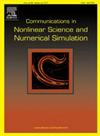Canard cycle, relaxation oscillation and cross-diffusion induced pattern formation in a slow–fast ecological system with weak Allee effect
IF 3.4
2区 数学
Q1 MATHEMATICS, APPLIED
Communications in Nonlinear Science and Numerical Simulation
Pub Date : 2024-09-21
DOI:10.1016/j.cnsns.2024.108360
引用次数: 0
Abstract
In this paper, we consider a Holling type IV functional response that describes a situation in which the predator’s per capita rate of predation decreases at sufficiently high prey density. Meanwhile it can be transformed into a Holling type II functional response in the limiting sense where predator’s attack rate increases at a decreasing rate with prey density until it becomes satiated. To explore the different dynamics of these two functional responses, we consider the slow–fast dynamic behavior of predator–prey system with Holling type IV and II functional responses, respectively, and make some simple comparisons of the dynamics of the system with these two functional responses. Specifically speaking, in the nonspatial case, firstly, the system with Holling type II functional response does not undergo a higher-codimension Hopf bifurcation. Then, the system with Holling type IV is extensively proved the existence of canard cycles and relaxation oscillations by using a range of analytical methods such as geometric singular perturbation technique, normal form of the slow–fast system, and the way in–way out function. In the spatial case, the temporal systems are extended to reaction–diffusion predator–prey systems. For the reaction–diffusion system with Holling IV, the different types of traveling wave are observed. Moreover, for the reaction–diffusion predator–prey system with Holling II, it is demonstrated that Turing instability occurs, which induces spatial heterogeneity patterns. Finally, the comparisons of the above dynamics of Holling Type IV and II functional responses in the non-spatial and spatial cases, respectively, are presented. From these comparisons, different Holling functional responses may be adopted for species at different stages or states, which is more conducive to maintaining species diversity and coexistence.
具有弱阿利效应的慢-快生态系统中的卡纳周期、弛豫振荡和交叉扩散诱导的模式形成
在本文中,我们考虑了霍林 IV 型功能响应,它描述了这样一种情况:当猎物密度足够高时,捕食者的人均捕食率会下降。同时,它也可以转化为限制意义上的霍林 II 型功能响应,即捕食者的攻击率随猎物密度的增加而递减,直至饱和。为了探索这两种功能响应的不同动力学特性,我们分别考虑了具有霍林 IV 型和 II 型功能响应的捕食者-猎物系统的慢-快动力学行为,并对具有这两种功能响应的系统的动力学特性进行了一些简单的比较。具体来说,在非空间情况下,首先,具有霍林 II 型功能响应的系统不会发生高维霍普夫分岔。然后,利用几何奇异扰动技术、慢-快系统的正态形式和进-退函数等一系列分析方法,广泛证明了霍林第四型系统存在卡纳循环和弛豫振荡。在空间情况下,时间系统被扩展为反应扩散捕食者-猎物系统。对于具有霍林 IV 的反应扩散系统,可以观察到不同类型的行波。此外,对于霍林 II 的反应扩散捕食者-猎物系统,证明了图灵不稳定性的发生,从而诱发了空间异质性模式。最后,分别对上述非空间和空间情况下霍林 IV 型和 II 型功能响应的动力学进行了比较。从这些比较中可以看出,处于不同阶段或状态的物种可能会采用不同的霍林功能响应,这更有利于维持物种的多样性和共存性。
本文章由计算机程序翻译,如有差异,请以英文原文为准。
求助全文
约1分钟内获得全文
求助全文
来源期刊

Communications in Nonlinear Science and Numerical Simulation
MATHEMATICS, APPLIED-MATHEMATICS, INTERDISCIPLINARY APPLICATIONS
CiteScore
6.80
自引率
7.70%
发文量
378
审稿时长
78 days
期刊介绍:
The journal publishes original research findings on experimental observation, mathematical modeling, theoretical analysis and numerical simulation, for more accurate description, better prediction or novel application, of nonlinear phenomena in science and engineering. It offers a venue for researchers to make rapid exchange of ideas and techniques in nonlinear science and complexity.
The submission of manuscripts with cross-disciplinary approaches in nonlinear science and complexity is particularly encouraged.
Topics of interest:
Nonlinear differential or delay equations, Lie group analysis and asymptotic methods, Discontinuous systems, Fractals, Fractional calculus and dynamics, Nonlinear effects in quantum mechanics, Nonlinear stochastic processes, Experimental nonlinear science, Time-series and signal analysis, Computational methods and simulations in nonlinear science and engineering, Control of dynamical systems, Synchronization, Lyapunov analysis, High-dimensional chaos and turbulence, Chaos in Hamiltonian systems, Integrable systems and solitons, Collective behavior in many-body systems, Biological physics and networks, Nonlinear mechanical systems, Complex systems and complexity.
No length limitation for contributions is set, but only concisely written manuscripts are published. Brief papers are published on the basis of Rapid Communications. Discussions of previously published papers are welcome.
 求助内容:
求助内容: 应助结果提醒方式:
应助结果提醒方式:


